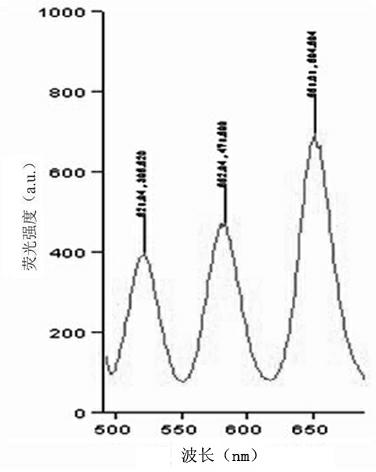Multi-component direct-competitive immunoassay method for labeling haptens by using quantum dots of micromolecule organic matters
An immunoassay, quantum dot technology, applied in analytical materials, material excitation analysis, measurement devices, etc., can solve the problems of high sample pretreatment requirements, low specificity, high detection cost, and eliminate washing and color reaction. steps, the effect of improving detection sensitivity and improving detection efficiency
- Summary
- Abstract
- Description
- Claims
- Application Information
AI Technical Summary
Problems solved by technology
Method used
Image
Examples
Embodiment Construction
[0012] 1. Example of Quantum Dot Labeled Pesticide Hapten Multi-component Direct Competitive Immunoassay Technology:
[0013] The fenvalerate hapten was converted to , 2,4D-butyric acid Carbofuran hapten (n=1-5) were covalently coupled with the core-shell structure (CdSe / ZnS) highly efficient water-soluble quantum dots with active amino groups on the surface, and the fluorescence emission wavelengths were 655nm, 585nm, and 525nm, respectively, and the characteristic fluorescence emission wavelength of the preparation was about The 655nm quantum dot-labeled fenvalerate hapten, the quantum dot-labeled 2,4D-butyric acid with a characteristic fluorescence emission wavelength of about 585nm, and the quantum dot-labeled carbofuran hapten with a characteristic fluorescence emission wavelength of about 525nm. Use an ultrafiltration centrifuge tube with a molecular weight cut-off of 5000 Daltons to remove free small molecular compounds, and use 0.05mol of pH8.3, 0.5g / L sodium azi...
PUM
 Login to View More
Login to View More Abstract
Description
Claims
Application Information
 Login to View More
Login to View More - R&D
- Intellectual Property
- Life Sciences
- Materials
- Tech Scout
- Unparalleled Data Quality
- Higher Quality Content
- 60% Fewer Hallucinations
Browse by: Latest US Patents, China's latest patents, Technical Efficacy Thesaurus, Application Domain, Technology Topic, Popular Technical Reports.
© 2025 PatSnap. All rights reserved.Legal|Privacy policy|Modern Slavery Act Transparency Statement|Sitemap|About US| Contact US: help@patsnap.com


